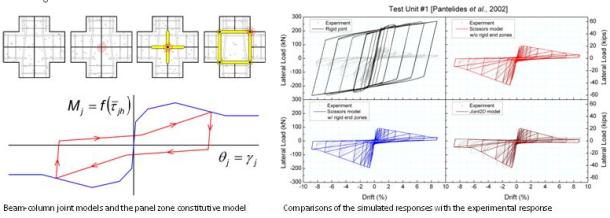Ozan Cem Celik – Structural Reliability, Risk Assessment, Performance Evaluation
Forced Vibration Testing of Existing Structures Celik OC, Sucuoglu H, Akyuz U [2003] Forced Vibration Testing of Reinforced Concrete Buildings Proceedings of the Fifth National Conference on Earthquake Engineering, May 26–30, Istanbul, Turkey, Paper No. AT-095.
Forced vibration tests were conducted on two different buildings in Ankara, Turkey: The first building was the Structural Mechanics New Laboratory Building of Civil Engineering Department of Middle East Technical University (METU), a two-story prefabricated reinforced concrete (RC) building. The objective in testing this building is to determine not only the dynamic properties of a prefabricated structure but also the influence of the nonstructural walls present in the overall dynamic behavior. The second building was the 4th block of MESA Yonca Evler Housing Complex, a nine-story RC building cast in by tunnel forms. The aim here besides testing an RC building cast in by tunnel forms was to test the structure without any nonstructural elements. Thus, it will help to compare the experimental results with analytical results as the discrepancies between these two have been generally attributed to the nonstructural elements. During the tests the excitation was provided via a vibration generator. The experimental frequency-response curves were plotted in the form of acceleration amplitude, normalized acceleration amplitude, and displacement amplitude versus excitation frequency. Translational mode natural frequencies and mode shapes were determined. The fundamental natural frequencies were found out to be 6.0 Hz for the prefabricated RC building and 3.2 Hz for the RC building cast in by tunnel forms. The experimental results were then compared with the free vibration analysis results. Moreover, the modal damping ratios, which cannot be computed directly from the structural properties or as a result of structural analysis, were also determined.
| Vibration generator Acceleration-frequency response curves of the METU Structural Mechanics Lab |
Modeling Reinforced Concrete Beam-Column Joints Celik OC and Ellingwood BR [2008] Modeling Beam-Column Joints in Fragility Assessment of Gravity Load Designed Reinforced Concrete Frames Journal of Earthquake Engineering, 12(3): 357–381
Reinforced concrete (RC) frame structures customarily have been designed in regions of low-to-moderate seismicity with little or no consideration of their seismic resistance. The move toward performance-based seismic engineering requires accurate reliability-based structural analysis models of gravity load designed (GLD) RC frames for predicting their behavior under seismic effects and for developing seismic fragilities that can be used as a basis for risk-informed decision-making. This analytical approach requires particular attention to the modeling of beam-column joints, where GLD frames differ significantly from their counterparts in high-seismic areas. This paper focuses on modeling shear and bond-slip behavior of beam-column joints for purposes of seismic fragility analysis of GLD RC frames. The joint panel constitutive parameters are defined to replicate the experimental joint shear stress-strain relationships, while the effect of bond-slip is taken into account through a reduced envelope for the joint shear stress-strain relationship. The joint model is validated using two full-scale experimental RC beam-column joint test series. A fragility assessment of an existing three-story GLD RC frame reveals the importance of modeling shear, anchorage and bond-slip in joints of GLD frames accurately when performing seismic risk assessments of buildings.
Seismic Risk Assessment of Structural Systems Celik OC and Ellingwood BR [2009] Seismic Risk Assessment of Gravity Load Designed Reinforced Concrete Frames Subjected to Mid-America Ground Motions, Journal of Structural Engineering (ASCE), 135(4): 414–424.
Ellingwood BR, Celik OC and Kinali K [2007] Fragility Assessment of Building Structural Systems in Mid-America, Earthquake Engineering and Structural Dynamics, Special Issue on Seismic Reliability Analysis of Structures, 36(13): 1935–1952.
The infrequent nature of earthquakes in the Central and Eastern United States (CEUS), and the fact that none with intensity comparable to the New Madrid sequence of 1811–12 has occurred in the past century, have caused the earthquake hazard in the CEUS to be neglected until quite recently. The performance of reinforced concrete (RC) frames in the CEUS may be deficient if they are subjected to earthquakes that are believed to be plausible in the New Madrid Seismic Zone (NMSZ). This study presents a set of probability-based tools for seismic vulnerability and risk assessment of such gravity load designed (GLD) RC frames, and uses these tools to evaluate the seismic vulnerability of RC frames that are representative of the building inventory in Memphis, TN — the largest population center close to the NMSZ. This evaluation indicates that traditional GLD RC frames have a substantial probability of suffering life-threatening damage or collapse in the event that they are subjected to earthquake demands stipulated in recent seismic design regulations such as ASCE Standard 7-05.
Courtesy NISEE
Sensitivity of Fragility Estimates to Aleatoric and Epistemic Uncertainties
Celik OC and Ellingwood BR [2009] Seismic Fragilities for Non-Ductile Reinforced Concrete Frames — Role of Aleatoric and Epistemic Uncertainties, Structural Safety, in press.
“Seismic fragilities are essential to earthquake loss estimation and performance-based earthquake engineering in regions of high seismicity. Construction practices for frames in regions of moderate seismicity are quite different, and such frames have received less attention in the literature. Fragilities for performance levels identified in recent seismic regulations are developed herein for reinforced concrete frames designed for gravity load in low-seismic regions using probabilistic nonlinear finite element analysis. An examination of the contribution of uncertainties in material and structural parameters reveals that structural damping, concrete strength, and cracking strain in beam-column joints have the greatest impact on the fragilities of such frames. However, fragilities that incorporate these sources of uncertainty are only slightly different from those based solely on the uncertainty in seismic demand from earthquake ground motion, suggesting that fragilities that are developed under the assumption that all structural parameters are deterministic and equal to their median (or mean) values are sufficient for purposes of earthquake damage and loss estimation in regions of moderate seismicity. Confidence bounds on the fragilities are also presented as a measure of their accuracy for risk-informed decision making, for prioritizing risk mitigation efforts in regions of low-to-moderate seismicity.













